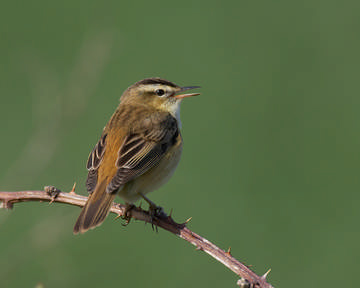Sedge Warbler (Acrocephalus schoenobaenus)

Sedge Warbler © Richard Steel
Sedge Warblers have slightly increased their range in the county, being found in 210 tetrads, up from 199 in First Atlas, but this general picture includes 96 gains and 85 losses. The map shows that they have quite a clustered distribution, with many breeding sites being 5 or 10 km from the next nearest birds. The newly-occupied tetrads are mainly around their existing strongholds: the North Wirral, a few coastal spots around the south Wirral, a crescent across the north of Cheshire from south of Chester to Warrington, a range of sites across the south of the county from Malpas to Sandbach, and locations around Northwich. There was no proven breeding in any tetrad above 100 m in altitude.
As with several of our trans-Saharan migrants, the national population was at its lowest at the end of our First Atlas period, following another failure of the African rains in autumn 1983, but their numbers have risen since, with some fluctuations, and the index in 2004 was 53% higher than in 1984. This is one of the classic species that migrates to spend the winter in the Sahel. Detailed analysis shows the survival of adult birds closely correlated with the annual west African rainfall, varying from around 50% in the wettest years to as little as 4% in the 1983 drought; this is the main factor driving year-to-year variation in population size (Peach et al 1991).
The BTO BBS analysis shows that the breeding population of Cheshire and Wirral in 2004-05 was 3,950 birds (with very wide confidence limits from zero to 9,420), corresponding to an average of about 36 birds per tetrad with confirmed or probable breeding, or 19 birds per tetrad in which the species was recorded. Sedge Warblers can breed at high densities at favoured sites. On 15 May 1999, surveyors recorded 256 singing males in the Woolston warbler count, an average of 1 bird per ha across the entire site. Changes in vegetation, especially the spread of Giant Hogweed Heracleum mantegazzianum and goose-grass (cleavers) Galium aparine, have since made much of the site less attractive to Sedge Warblers, but during this Atlas survey there was an average of 100 males singing there each year. Other sites reported during this period with high totals include Inner Marsh Farm, Frodsham Marsh and Moore/ Gatewarth.
Almost half of the Atlas records (99) were of birds singing only, and many observers added comments such as ‘moved on’, ‘did not stay’, and ‘found on early visit only’. However, most male Sedge Warblers stop, or greatly reduce, their singing soon after pairing, and it is difficult to know whether these ‘S’ records truly indicate birds that were merely on passage or if they should point to higher levels of breeding status. The females build a nest on or near the ground, with the typical site in rank vegetation often near water, although at the species’ stronghold at Woolston, most of the nests found have been in nettles and often hundreds of metres away from water. The normal clutch is 5 eggs, chicks hatching around the beginning of June, with occasional second broods into August. Birds carrying food are very obvious, and one-quarter of the total (52 tetrads) provided ‘FY’ records.
Sedge Warblers can use a wide variety of habitats, and records were submitted for this survey with as many as 36 different habitat codes. As many as 45% of the tetrad records were accompanied by a ‘G’ habitat code – freshwater body – and the top five codes, accounting for more than 60% of the records, were C7 (Reed swamp), B1 (Regenerating natural or semi-natural woodland), G8 (Ditch with water (less than 2m wide)), G3 (Lake/unlined reservoir) and C6 (Water-meadow/ grazing marsh).
Sponsored by Syngenta CTL

